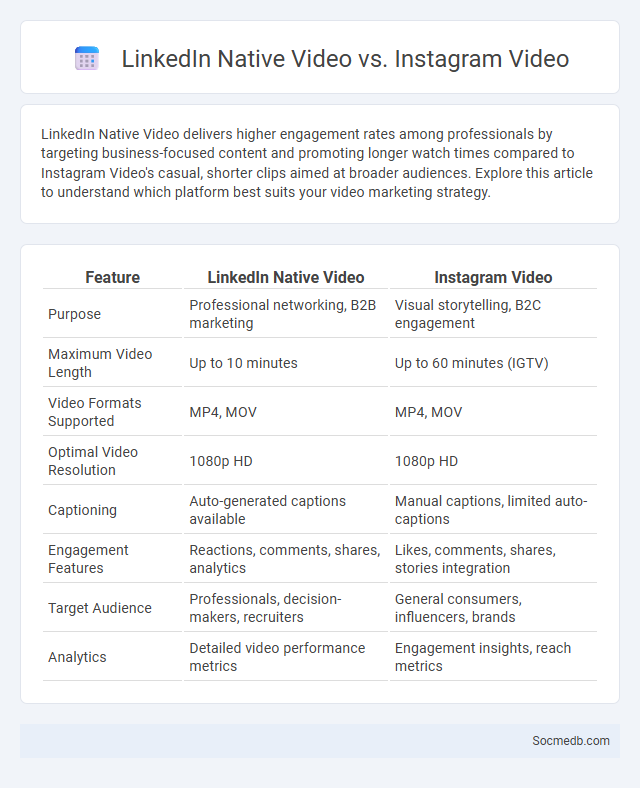
Photo illustration: LinkedIn Native Video vs Instagram Video
LinkedIn Native Video delivers higher engagement rates among professionals by targeting business-focused content and promoting longer watch times compared to Instagram Video's casual, shorter clips aimed at broader audiences. Explore this article to understand which platform best suits your video marketing strategy.
Table of Comparison
| Feature | LinkedIn Native Video | Instagram Video |
|---|---|---|
| Purpose | Professional networking, B2B marketing | Visual storytelling, B2C engagement |
| Maximum Video Length | Up to 10 minutes | Up to 60 minutes (IGTV) |
| Video Formats Supported | MP4, MOV | MP4, MOV |
| Optimal Video Resolution | 1080p HD | 1080p HD |
| Captioning | Auto-generated captions available | Manual captions, limited auto-captions |
| Engagement Features | Reactions, comments, shares, analytics | Likes, comments, shares, stories integration |
| Target Audience | Professionals, decision-makers, recruiters | General consumers, influencers, brands |
| Analytics | Detailed video performance metrics | Engagement insights, reach metrics |
Understanding LinkedIn Native Video
LinkedIn Native Video is a powerful tool for increasing engagement by directly uploading videos to the platform, ensuring higher visibility in users' feeds compared to shared links. Optimizing video content with relevant keywords, captions, and clear calls-to-action can significantly enhance viewer retention and lead generation on professional networks. Utilizing LinkedIn's analytics allows for detailed insights into audience demographics and video performance, enabling strategic adjustments to maximize reach and impact.
Features of Instagram Video Content
Instagram video content features include Reels, which offer 15 to 90-second multi-clip videos with audio, effects, and new creative tools to engage users. IGTV supports longer videos up to 60 minutes for in-depth storytelling, while Stories provide 15-second ephemeral clips that disappear after 24 hours, enhancing real-time interaction. Interactive elements such as polls, stickers, and swipe-up links boost viewer engagement and increase content reach across Instagram's platform.
Defining Native Video Across Platforms
Native video refers to video content that is uploaded directly to a social media platform rather than shared via third-party links, enhancing user engagement and reach. Platforms like Facebook, Instagram, TikTok, and LinkedIn prioritize native videos through algorithms, favoring in-app playback and autoplay features that boost viewer retention. Optimizing videos for each platform's specifications--such as aspect ratio, length, and captioning--maximizes visibility and effectiveness in driving audience interaction.
Audience Engagement: LinkedIn vs Instagram vs Native
Audience engagement varies significantly across LinkedIn, Instagram, and native platforms, with LinkedIn excelling in professional interactions and B2B networking, generating higher quality leads through detailed content and targeted groups. Instagram drives engagement through visual storytelling and influencer collaborations, capturing younger demographics with interactive features like Stories, Reels, and hashtags. Your choice depends on whether you prioritize professional credibility, visual appeal, or seamless integration within your website or app environment for authentic user interaction.
Video Performance Metrics Comparison
Analyzing video performance metrics such as view count, engagement rate, watch time, and click-through rate provides critical insights into your social media strategy's effectiveness. High engagement rates combined with longer watch times indicate strong audience retention and content relevance, while view count alone may not fully capture your video's impact. Comparing these metrics across platforms enables you to optimize content tailored to each audience, maximizing reach and conversion potential.
Branding Opportunities on Each Platform
Social media platforms offer distinct branding opportunities tailored to diverse audiences and content formats. Instagram excels in visual storytelling through images and short videos, while LinkedIn provides a professional environment to establish industry authority and network with potential clients. Understanding these unique strengths allows you to strategically enhance your brand presence and engage effectively with your target market.
Content Creation Best Practices
Effective content creation on social media requires understanding your audience's preferences and delivering consistent, high-quality posts that engage and provide value. Incorporate visually appealing elements, such as images, videos, and infographics, optimized for each platform to boost interaction and sharing. Scheduling your content at peak times and analyzing performance metrics ensures your strategy adapts to trends, maximizing reach and impact for your brand.
Algorithm Impact on Video Reach
Social media algorithms prioritize content based on user engagement metrics such as likes, shares, and watch time, significantly influencing video reach. Videos that capture viewer attention within the first few seconds and encourage interaction are ranked higher, increasing visibility across platforms like TikTok, Instagram, and YouTube. Understanding and leveraging algorithmic preferences can drastically enhance organic video reach, boosting brand awareness and audience growth.
Pros and Cons: LinkedIn vs Instagram vs Native Video
LinkedIn offers professional networking and B2B marketing advantages, making it ideal for career development and industry connections, but its user engagement can be lower compared to more casual platforms. Instagram excels in visual storytelling and brand promotion with high user interaction, yet it may lack depth for serious business communication and lead generation. Native video content enhances viewer retention and platform algorithms favoring engagement, but creating quality videos demands more time and resources, impacting Your content strategy's efficiency.
Choosing the Right Platform for Your Video Strategy
Selecting the ideal social media platform for your video strategy ensures maximum engagement and audience reach by aligning content style with user demographics and platform features. Platforms like YouTube excel in long-form video content, while TikTok and Instagram favor short, visually captivating clips that cater to younger audiences. You can optimize your video's impact by analyzing metrics and audience behavior unique to each platform to tailor content effectively.
 socmedb.com
socmedb.com